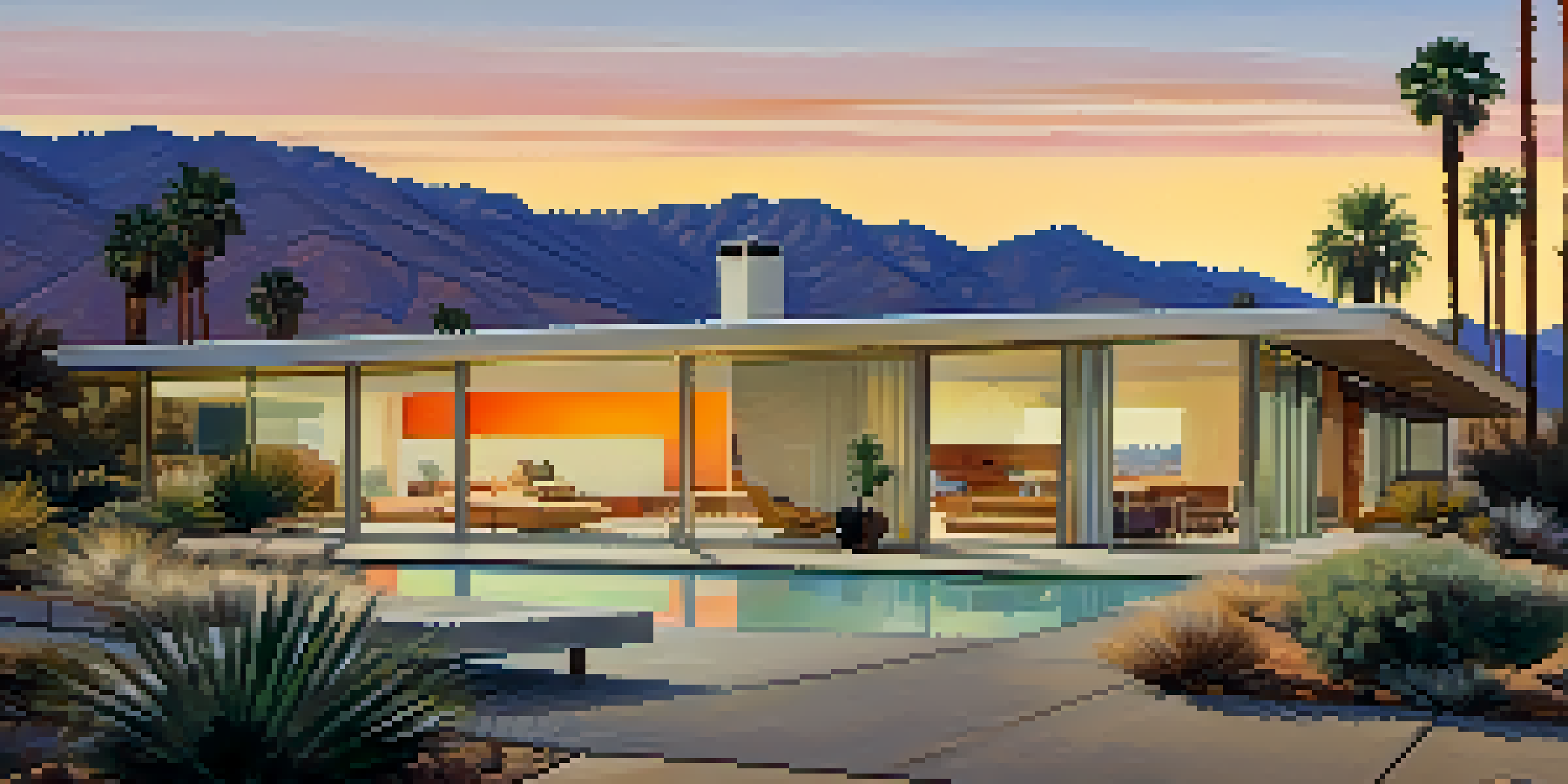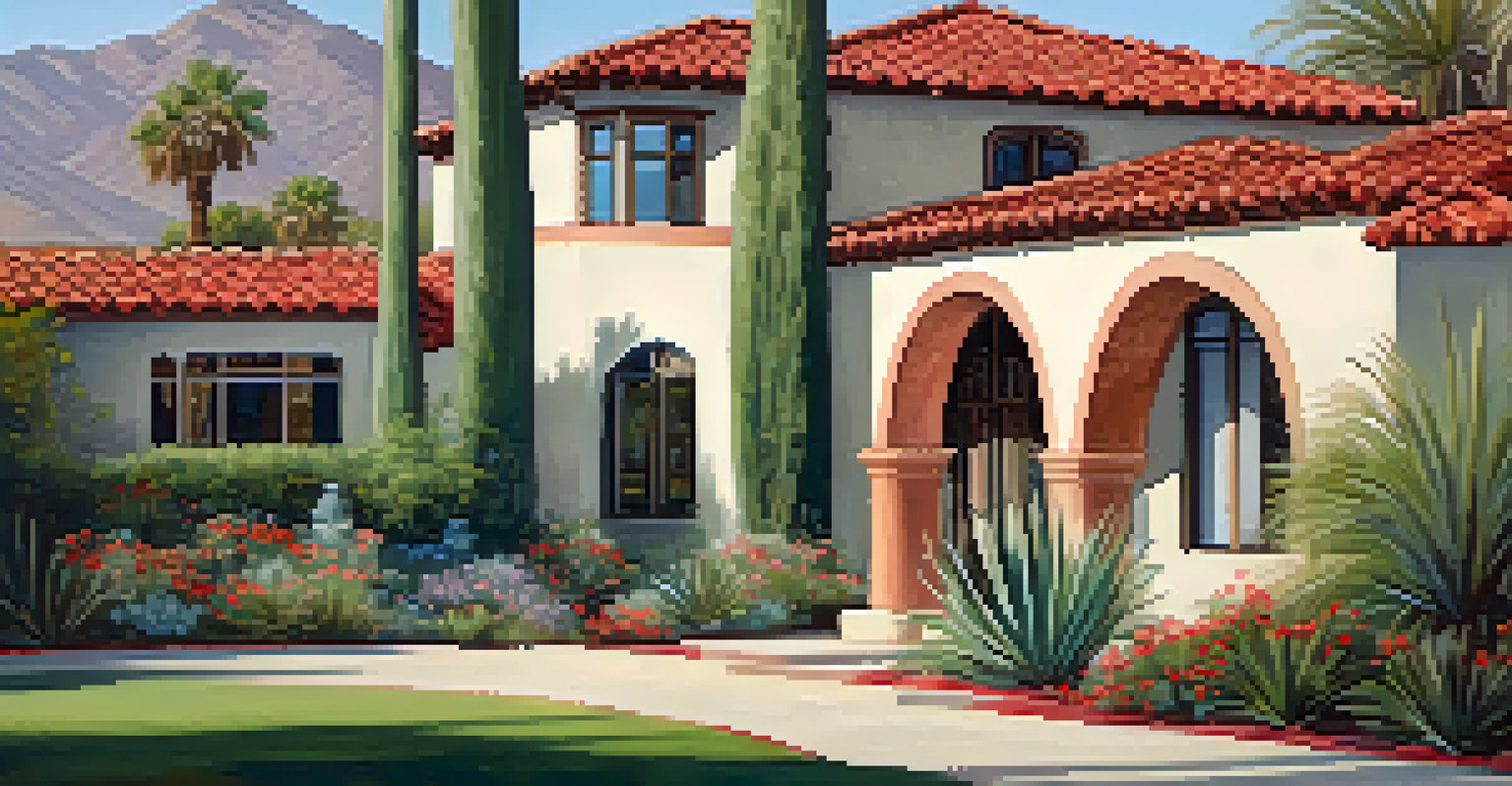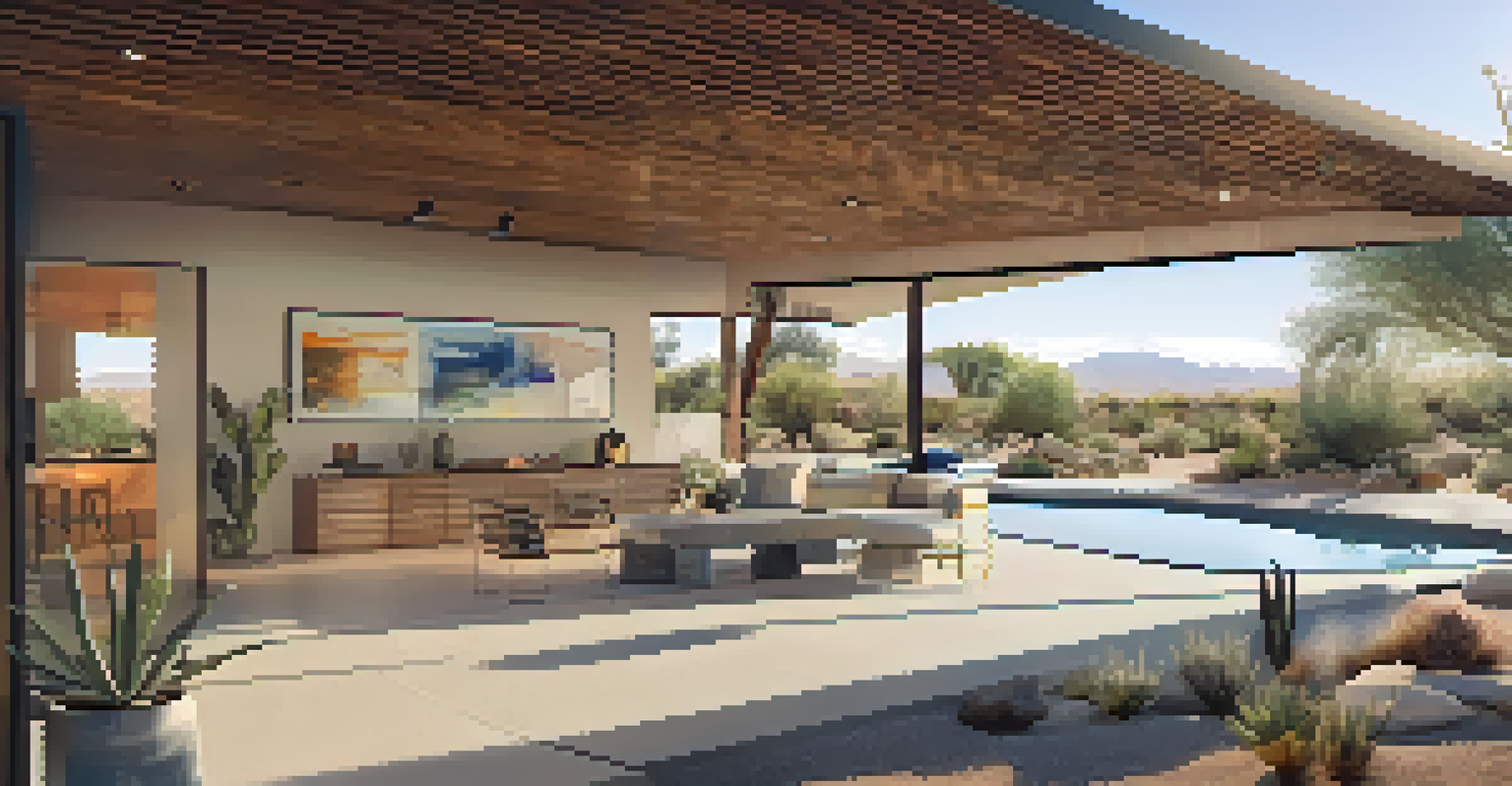Exploring Palm Springs: A Guide to Architectural Diversity

Introduction to Palm Springs’ Architectural Landscape
Palm Springs is a vibrant oasis in the California desert, known for its stunning architecture. The city’s unique blend of styles reflects its rich history and cultural influences, making it a treasure trove for architecture enthusiasts. From mid-century modern homes to elegant Spanish Revival buildings, there’s something for everyone to admire.
Architecture should speak of its time and place, but yearn for timelessness.
One of the most fascinating aspects of Palm Springs is how architecture evolved with the city’s growth. In the early 20th century, the area attracted Hollywood stars and wealthy vacationers, leading to a surge in bold architectural designs. This laid the groundwork for the diverse styles that would flourish in the years to come.
As we explore Palm Springs, we’ll delve deeper into the architectural gems that define its character. Each neighborhood tells a different story, showcasing the creativity and innovation that have shaped this desert paradise.
Mid-Century Modernism: The Heart of Palm Springs
Mid-century modernism is perhaps the most iconic architectural style associated with Palm Springs. This movement, which gained popularity in the 1950s, emphasizes clean lines, large windows, and a strong connection to nature. Notable architects like Richard Neutra and Albert Frey played pivotal roles in defining this aesthetic, creating homes that are both functional and beautiful.

Walking through neighborhoods like the Twin Palms and the Movie Colony, you can see the hallmark features of mid-century modern homes. The open floor plans and integration with the surrounding landscape invite residents to enjoy the stunning desert views. Many of these homes have been lovingly restored, showcasing their original charm while incorporating modern comforts.
Architectural Diversity in Palm Springs
Palm Springs showcases a rich blend of architectural styles, including mid-century modernism, Spanish Revival, and contemporary designs.
The Palm Springs Modernism Week, held annually, celebrates this architectural legacy, drawing visitors from around the world. It’s a fantastic opportunity to tour these homes, meet passionate owners, and appreciate the enduring appeal of mid-century design.
Spanish Revival: A Touch of Old World Charm
While mid-century modernism dominates the landscape, the Spanish Revival style adds a touch of old-world charm to Palm Springs. This architectural style, characterized by stucco exteriors, red-tiled roofs, and arched doorways, draws inspiration from the Spanish colonial period. You’ll find enchanting examples of this style scattered throughout the city, particularly in neighborhoods like El Mirador.
Good buildings come from good people, and all problems are solved by good design.
The Spanish Revival homes often feature vibrant tile work, wrought-iron details, and lush courtyards that evoke a sense of tranquility. These elements create an inviting atmosphere, perfect for enjoying the warm desert evenings. The style’s romance is not just in its aesthetics; it reflects the history of the region and its cultural influences.
For those who appreciate a blend of history and beauty, exploring these Spanish Revival homes offers a glimpse into a different era. They remind us of the diverse cultural tapestry that makes Palm Springs so unique.
Desert Modernism: Blending with the Landscape
Desert modernism is an architectural style that emerged as a response to the harsh desert environment of Palm Springs. It emphasizes sustainability and harmony with nature, often using natural materials and colors that blend seamlessly with the surroundings. This style prioritizes energy efficiency, making it particularly relevant in today’s eco-conscious world.
Homes designed in this style often feature large overhangs, shaded outdoor spaces, and expansive glass walls that invite the beauty of the desert indoors. Many architects today are inspired by this movement, designing homes that are not only striking but also environmentally friendly. This trend reflects a growing awareness of the importance of sustainability in architecture.
Importance of Historic Preservation
The city actively preserves its mid-century architectural gems through local ordinances and community efforts, reflecting a commitment to its history.
Visiting neighborhoods like Andreas Hills, you can see how desert modernism continues to evolve. The innovative designs showcase how architecture can adapt to its environment while still making a bold statement.
Contemporary Styles: Innovation and Creativity
As Palm Springs continues to evolve, contemporary architecture has begun to carve out its own niche in the city. This style often incorporates cutting-edge design elements and materials, resulting in homes that are both striking and functional. Architects today are pushing boundaries, creating unique spaces that reflect modern living.
Contemporary homes in Palm Springs often feature open floor plans, smart home technology, and sustainable materials. They embrace the desert environment by maximizing natural light and outdoor living spaces, making them perfect for the sunny climate. This blend of innovation and practicality attracts a new generation of homeowners looking for something fresh.
Exploring areas like the Vista Las Palmas neighborhood showcases how contemporary architecture has transformed the landscape. It’s a testament to Palm Springs’ commitment to architectural diversity and its willingness to embrace change.
Historic Preservation: Protecting Palm Springs’ Heritage
As the architectural landscape of Palm Springs evolves, historic preservation plays a crucial role in maintaining the city’s unique character. Many iconic buildings from the mid-century era are protected under local ordinances, ensuring that their architectural significance is preserved for future generations. This commitment to preservation reflects the community’s appreciation for its rich history.
Organizations like the Palm Springs Historical Society work tirelessly to educate residents and visitors about the importance of preserving these architectural gems. Guided tours and events help raise awareness, allowing people to appreciate the stories behind the structures. These efforts foster a sense of pride in the city’s heritage and encourage responsible development.
Engaging Architectural Tours and Events
Organized tours and events like Modernism Week provide opportunities for residents and visitors to explore and appreciate Palm Springs' architectural heritage.
Preserving Palm Springs’ architectural diversity not only enhances its charm but also supports tourism. Visitors flock to the city to experience its unique blend of styles, contributing to the local economy while also celebrating its rich history.
Exploring Palm Springs: Architectural Tours and Events
One of the best ways to appreciate Palm Springs’ architectural diversity is through organized tours and events. Several companies offer guided tours that focus on specific styles or neighborhoods, providing insights and stories from knowledgeable guides. Whether you’re a seasoned architecture buff or a curious traveler, these tours offer a unique perspective on the city’s design heritage.
Events like Modernism Week not only showcase the beauty of mid-century design but also feature lectures, film screenings, and home tours. It’s a celebration of creativity and innovation, attracting thousands of visitors who want to immerse themselves in Palm Springs’ architectural scene. This annual event highlights the city’s importance as a hub for modern design.

Participating in these tours and events allows you to connect with fellow architecture enthusiasts and local experts. It’s a fantastic opportunity to learn, explore, and appreciate the diverse styles that make Palm Springs a truly unique destination.
Conclusion: Embracing Architectural Diversity in Palm Springs
Palm Springs stands as a beacon of architectural diversity, where each style tells a story of creativity and culture. From mid-century modern homes to Spanish Revival gems, the city celebrates its rich history while embracing contemporary innovation. This blend of old and new creates a vibrant atmosphere that captivates residents and visitors alike.
As you explore Palm Springs, take time to appreciate the details that make each architectural style unique. Whether you’re wandering through historic neighborhoods or admiring modern masterpieces, the city’s design landscape offers endless inspiration. The architectural diversity is not just about aesthetics; it reflects the community’s values and commitment to preserving its heritage.
In a world where trends come and go, Palm Springs remains a timeless destination for architecture lovers. It invites everyone to explore, learn, and celebrate the beauty of diverse architectural styles that define this desert paradise.